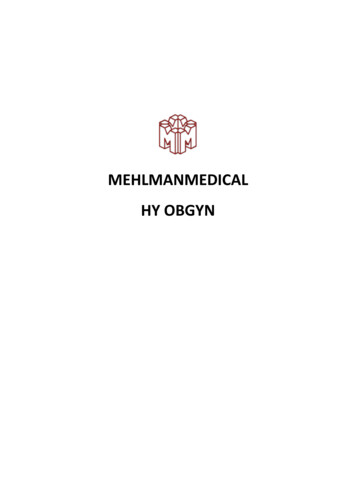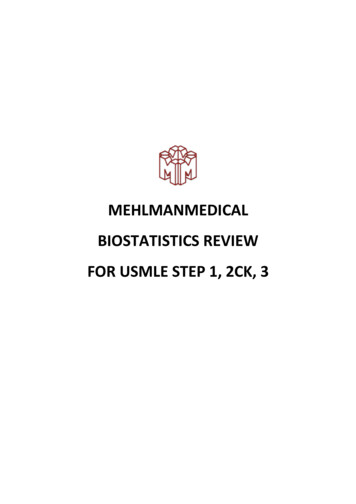
Transcription
MEHLMANMEDICALHY OBGYN
MEHLMANMEDICAL.COMHY ObgynPurpose of this review is not to be a 600-page obgyn textbook with every detail catered to; the purpose is to increase yourUSMLE and Obgyn shelf scores via concise factoid consolidation.-32F not breastfeeding upper-outer quadrant warm, tender, red non-fluctuant mass /- fever; Dx?à answer on Obgyn NBME mastitis, not breast abscess; the key here is non-fluctuant mass;abscess is identical presentation but fluctuant. For mastitis, the easier, Step 1 presentation is thestandard red, cracked, fissured nipple in a breastfeeding woman à S. aureus à Tx continuebreastfeeding through the affected breast; can give oral dicloxacillin (answer on newer Obgyn form)or cephalexin for mastitis; for abscess, answer always drain before Abx.-32F recently stopped breastfeeding temp 99.5F tender, fluctuant mass in lateral breast notwarm not erythematous; Dx? à answer on Obgyn NBME galactocele (milk retention cyst);classically subareolar or in lateral breast; Tx on Obgyn NBME is warm compresses (“application ofheat to the area”).-31F gave birth two days ago exclusively bottle-feeding neonate breasts are engorged and tender fever of 101F Sx of dysuria suprapubic tenderness urinalysis normal; Dx? à answer on ObgynNBME breast engorgement à every student gets this wrong because it sounds like obviousinfection; learning point is: can present with fever; occasional Sx of dysuria normal U/A are notatypical in women.-24F amenorrhea since D&C 13 months ago for postpartum hemorrhage progestin withdrawal testshows no withdrawal bleeding; Dx? à answer Asherman syndrome or “uterine synechiae” onObgyn shelf.-27F spontaneous abortion at 10 weeks gestation complicated by postpartum endometritis sharpD/C to remove infected material; patient is subsequently at increased risk for what? answer amenorrhea (Asherman syndrome).-What does progestin withdrawal test mean? à if progestin is given then withdrawn, bleeding shouldoccur (hormonal stabilization of lining followed by allowing it to slough, akin to forcing amenstruation); if bleeding occurs, estrogen is not deficient and the Dx is anovulation (PCOS is justanovulation leading to 11 cysts bilaterally hirsutism; anovulation as independent term is samemechanism as full-blown PCOS) à if anovulation occurs, there’s no corpus luteum and therefore noMEHLMANMEDICAL.COM2
MEHLMANMEDICAL.COMprogesterone released à cannot establish endogenous rise fall of progestin, therefore nosloughing/menstruation; in contrast, if bleeding does not occur with progestin withdrawal test, eitherestrogen is deficient (primary ovarian failure or hypogonadotropic disorder) or the uterus is scarred(Asherman).-18F no bleeding after progestin withdrawal test; Q asks, if not Tx over ten years, what is patient atrisk for? à answer osteoporosis (progestin withdrawal result means low estrogen).-Question shows you a graph where basal body temperature increases 0.5F mid-cycle and stays atthis higher temp; why? à answer progesterone (ovulation).-45F she asks about best way to decrease risk of osteoporosis; answer weight-bearing exercise, notcalcium vitamin D.-72F already has osteoporosis Q asks best way to most greatly decrease fracture risk; answer going on long walks; wrong answer is swimming / pool exercises (weight-bearing component makessense, but actually tricky considering elderly have high falls risk).-69F Caucasian nulliparous on beta-blocker drinks daily compression fracture of vertebra;what is strongest predisposing risk factor (family Hx not discussed or listed)? à answer race; whiterace confers higher risk of osteoporosis; wrong answers are alcohol use, beta-blocker, nulliparity,HTN.-42F 8-month Hx of severe pelvic pain and heavy bleeding during menses regular periods twokids does not want more kids husband to get vasectomy soon no other abnormalities; next beststep? à answer endometrial ablation.-11F Tanner stage 3 breast and pubic hair; these findings are most predictive of what? à answer “menarche is imminent.” USMLE wants you to know that menarche is imminent once girl is Tannerstage 3. Normal sequence is adrenarche à thelarche à pubarche à menarche.-13F Tanner stage 2 never had menstruation brought in by mom concerned about lack ofmenstruation; answer follow-up in 6 months (Tanner stage 2 so menarche is not yet imminent).-14F 4x6cm mass in left breast slightly tender vitals normal aunt died of breast cancer; nextbest step? à follow-up in 6 months à virginal breast hypertrophy is normal response to increasedestrogens in adolescence (also seen in males; asked on peds and FM shelves).MEHLMANMEDICAL.COM3
MEHLMANMEDICAL.COM-23F 10 weeks gestation nausea and vomiting for 4 weeks lost 1.8kg; what is the most likelyadverse effect on the fetus? à answer “no significant adverse effect.”-How to Dx hyperemesis gravidarum (HG)? à answer urinary ketones.-When does HG present what’s the mechanism? à 8-10 weeks gestation; an effect of beta-hCG(levels are highest at 8-10 weeks).-Biochemical disturbance in HG? à hypokalemic, hypochloremic, metabolic alkalosis (low K, low Cl,high bicarb); yes, they ask this on Obgyn shelf.-Tx for HG? à answer admit to hospital and give parenteral anti-emetic therapy.-Important drug causing hyperprolactinemia apart from antipsychotics? à metoclopramide à D2antagonist.-Anorexia in patient with anorexia; why? à decreased GnRH pulsation (hypogonadotropic) àdecreased LH FSH; Q wants “ FHS, estrogen” as the answer; in contrast, premature ovarianfailure, Turner syndrome, and menopause have “ FHS, estrogen” as the answer.-28F tight-fitting sports bra and/or breast trauma; Dx? à fat necrosis (can calcify).-36F rubbery, mobile, painless mass in breast; Dx? à fibroadenoma à first Dx with USS only if age 30; do USS /- mammogram if age 30; do FNA next; if confirmed, Tx surgical excision; should benoted that guidelines vary (i.e., observe for change, etc.), but excision is definitive. Obgyn shelf willonly ask you for Dx based on presentation.-Mammogram guidelines? à start age 50 every two years until age 75.-44F painless unilateral cyst in breast that drains brown serous fluid; Dx? à answer on Surg form 6 fibrocystic change; everyone says wtf because, yes, classic presentation is bilateral breast tendernessin woman 20s-40s that waxes and wanes with menstrual cycle; Tx is supportive (Evening Primrose oil/ warm bath); histological descriptors can be: sclerosing adenosis; blue dome cysts; apocrinemetaplasia.-25F sharp pain in outer quadrant of right breast exam shows 2cm tender area in right breast butno mass found; Dx? à answer fibrocystic change.-47F breast lump self-palpated breast USS shows 3cm complex cyst FNA performed of the cystrevealing straw-colored fluid mass still present after aspiration; next best step? à answer biopsyof the mass.MEHLMANMEDICAL.COM4
MEHLMANMEDICAL.COM-45F unilateral rusty nipple discharge; Dx? à intraductal papilloma until proven otherwise.-45F unilateral rusty nipple discharge biopsy shows stellate morphology; Dx? à answer invasiveductal carcinoma, not intraductal papilloma.-45F mammography shows cluster of microcalcifications in upper-outer quadrant; next best step? àanswer needle-guided open biopsy (FNA wrong answer) à microcalcifications are ductal carcinomain situ (DCIS) until proven otherwise.-45F inverted nipple greenish discharge; Dx? à mammary ductal ectasia (widening of lactiferousduct).-42F recurrent miscarriage SLE; Dx? à antiphospholipid syndrome (lupus anticoagulant) à Obgynshelf will ask for “uteroplacental insufficiency” as the answer à Tx with aspirin or heparin; warfarin iscontraindicated in pregnancy (bone abnormalities bleeding in fetus).-45F SLE commencing third course of corticosteroids during past 18 months; Q asks what else sheshould be given; answer “alendronate now” à give bisphosphonate to patients commencingsteroids indefinitely, or to patients receiving steroids frequently.-Intrauterine growth restriction (IUGR) of the fetus; which lifestyle factor most contributory; answer smoking, not alcohol à causes decreased placental blood flow à answer “Doppler ultrasonographyof the umbilical artery.”-Which fetal parameter most reflective of IUGR? à abdominal circumference; sounds wrong, as you’dexpect perhaps femur length, or biparietal diameter, etc., but answer is abdominal circumference.-23F 33 weeks gestation FVL mutation intrauterine female demise; Q asks which vessel thethrombosis most likely occurred in; answer uteroplacental artery.-Female at 24 weeks gestation HTN proteinuria; most likely cause for her findings? à answer “uteroplacental insufficiency” or “placental dysfunction”; this is the cause of preeclampsia.-Female at 16 weeks gestation HTN proteinuria fundal height measured at the umbilicus; Dx? àanswer hydatidiform mole, not preeclampsia; preeclampsia will occur after 20 weeks gestation;molar pregnancy presents large for gestational age à fundal height at umbilicus is normally reflectiveof 20 weeks gestation.-Uteroplacental insufficiency can cause what issue on the fetal heart tracing? à answer latedecelerations (fetal hypoxia).MEHLMANMEDICAL.COM5
MEHLMANMEDICAL.COM-What do early, variable, and late decels mean? à early fetal head compression; variable cordcompression; late fetal hypoxia.-Fetus has HR at 120bpm (NR 110-160), however there’s zero variability; Dx? à answer on ObgynNBME fetal sleep state.-Fetus has HR at 180bpm, however there’s zero variability; Dx? à answer on Obgyn NBME maternalfever.-What are accelerations? à fetal well-being à rise of 20bpm lasting 20 seconds; 2-3 occurencesevery 20 minutes.-What is a biophysical profile? à assesses fetal wellbeing; often done when non-stress test (checkingfor accelerations) is non-reactive; five components of biophysical profile (you do not need to havethese memorized for the USMLE; more just be aware that if the vignette mentions qualitative nonreassurance of any aspect of the biophysical profile, then there is possibly fetal/maternal pathology):-oNon-stress test shows at least two accelerations in 20 minutes.oRhythmic breathing episode of 30 seconds in 20 minutes.oFetal movements (at least 2 or 3 of the limbs).oFetal muscle tone (at least one episode of flexion/extension of the trunk limbs together).oAmniotic fluid volume (at least 2cm in vertical axis, or fluid index 5cm).21F 41 weeks gestation 4cm dilated variable decels; next best step? à answer on Obygn NBME amnioinfusion (wrong answers were external cephalic version, forceps delivery, amniocentesis,cordocentesis) à can’t attempt delivery if not 10cm dilated forceps not tried first anyway becauseit can cause nerve damage (vacuum extraction / suction cup delivery first).-What is external cephalic version? à transabdominal manipulation of a breech fetus into cephalicengagement; only performed after 36 weeks, as the fetus can spontaneously engage cephalicallyprior.-What is internal podalic version? à reorienting fetus within the womb during a breech delivery; maybe attempted for transverse and oblique lies when C-section not performed; also used for delivery ofsecond twins.-2-day-old neonate purplish fluctuant mound on scalp crosses suture lines; Dx? à caputsuccedaneumMEHLMANMEDICAL.COM6
MEHLMANMEDICAL.COM-Difference between caput succedaneum and cephalohematoma?oCaput succedaneum is poorly defined soft tissue edema on the scalp; caused by pressure offetal scalp against cervix during parturition, leading to transient decreased blood flow andreactive edema; crosses suture lines; can be purplish in color similar to cephalohematoma(i.e., don’t use color to distinguish); complications rare; disappears in hours to few days.oCephalohematoma is well-defined, localized, fluctuant swelling; caused by subperiostealhemorrhage; does not cross suture lines; may be associated with underlying skull fracture,clotting disorders, jaundice; disappears in weeks to months.-32F G1P0 third trimester itchy hives-like eruptions within abdominal striae; Dx Tx? à answer pruritic urticarial papules and plaques of pregnancy (PUPPP); occurs in 1/200 pregnancies (usuallyprimigravid); cause is unknown, presents as pruritic hives-like eruption within striae; Tx is with topicalemollients; for severe cases, topical steroids can be given; resolves spontaneously within a week ofdelivery.-25F G1P0 third trimester itchy palms soles; Dx Tx? à answer intrahepatic cholestasis ofpregnancy (ICP); usually occurs third trimester; pruritis, particularly of palms soles; diagnosis isachieved by ordering serum bile acids (elevated); Tx ursodeoxycholic acid (ursodiol); important tonote that ICP is associated with increased risk of third-trimester spontaneous abortion – i.e., it isnot benign; delivery at 35-37 weeks may be considered; if bile acid levels normal, new literaturesuggests waiting until 39 weeks is acceptable.-32F 30 weeks gestation 10-day Hx of nausea and generalized itching bilirubin 2.1 mg/dL ALT/AST/ALP all normal; Dx? à Obgyn shelf answer intrahepatic cholestasis of pregnancy; nomention of palms soles itching in vignette.-36F G1P0 36 weeks gestation nausea/vomiting jaundice high bilirubin high ALT and AST no mention of pruritis of palms/soles; Dx? à answer acute fatty liver of pregnancy; caused bydeficiency of long-chain 3-hydroxyacyl-CoA dehydrogenase (sounds absurdly pedantic but asked onObgyn shelf); often fatal; Tx is IV hydration hepatology/high-risk obgyn consults delivery.-29F G1P0 2nd or 3rd trimester intensily itchy eruption around umbilicus that spreads outward; Dx Tx? à answer herpes gestationis (gestational pemphigoid); not HSV, but instead an idiopathicautoimmune phenomenon; Tx topical steroids.MEHLMANMEDI
Obgyn shelf will only ask you for Dx based on presentation. - Mammogram guidelines? à start age 50 every two years until age 75. - 44F painless unilateral cyst in breast that drains brown serous fluid; Dx? à answer on Surg form 6 fibrocystic change; everyone says wtf because, yes, classic presentation is bilateral breast tenderness in woman 20s-40s that waxes and wanes with menstrual .











